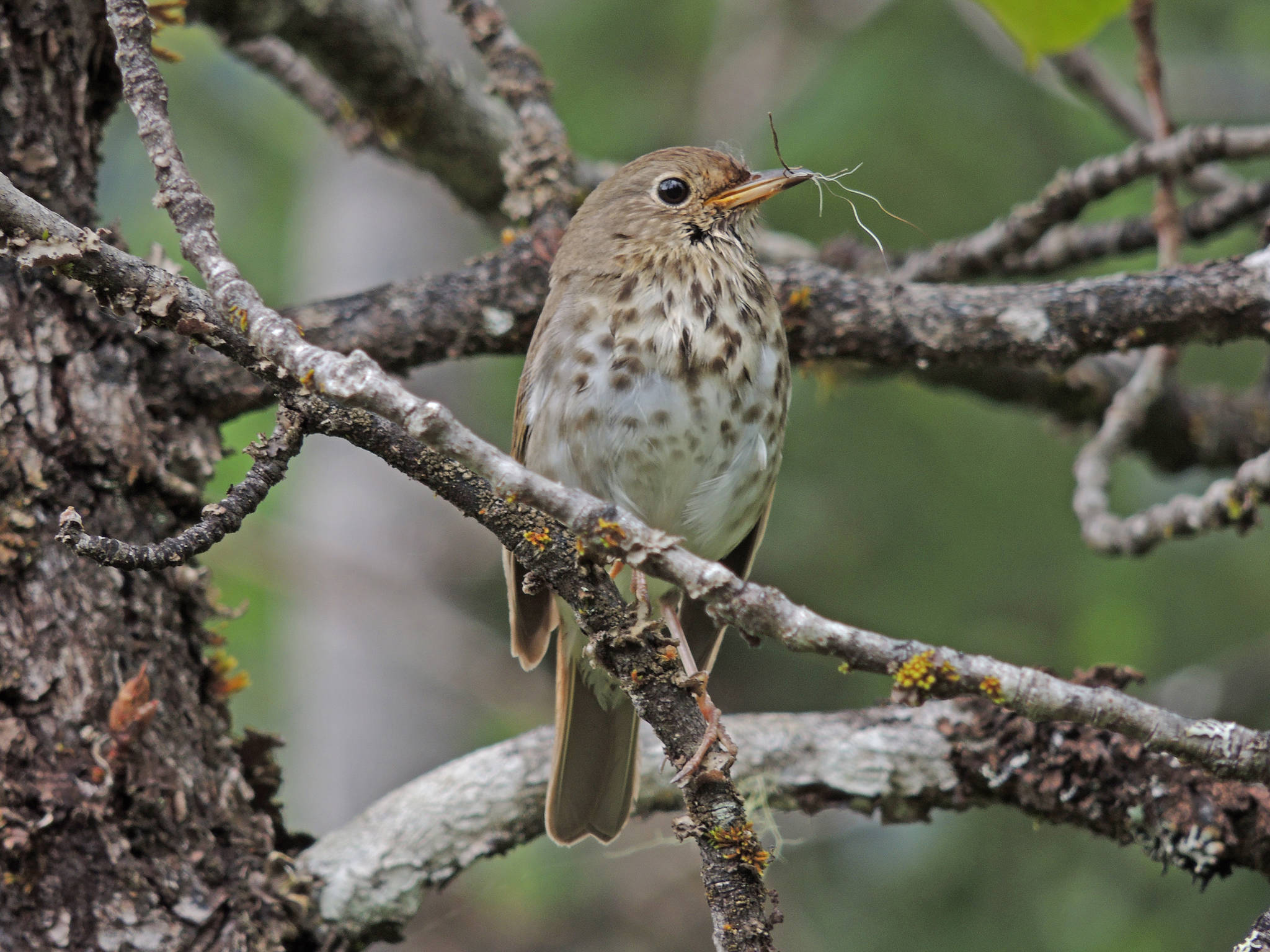In early June, Parks & Rec hikers went up the Sheep Creek trail on a day of fitful rain showers and intermittent sunshine. This is a favorite trail, but it was clear that the trail could use some work! The uphill portion of the trail is seriously eroded by water coursing down the trail. The long traverse below the road is cut by deep erosional gullies and the edge of the trail is collapsing in spots. Along this stretch, cow parsnip overhangs and obscures the trail. Once in the valley proper, the going is easier, although several wind-shattered cottonwoods and sagging willows lie across the trail and there are more erosion cuts. Some of these things are easily fixed, while others are significantly more challenging.
This was a good time to go up into the valley, because it is rich in nesting, singing songbirds. Even though the P&R summer hikes begin well after the early-morning chorus of bird song (and my hearing is not as good as it once was), I identified the songs of 12 songbird species, plus hooters on the hillsides. One species in particular was a treat: Swainson’s thrushes commonly nest up there but they arrive later than the others; I don’t usually hear them until June. By that time, robins and fox sparrows are feeding chicks and juncos have fledglings.
Swainson’s thrushes nest all across northern North America and down along the Rockies. They spend the winter mostly in southern Central America and northern South America, although some go as far as northern Argentina. When they at last arrive here in spring, the female builds a nest, usually in the understory, lays her eggs and incubates them, while the male sings. But both parents tend the chicks. Hearing the song of that species is certainly a treat for me, but my favorite remains the ruby-crowned kinglet’s cheering carols from the canopy.
Right next to the trail we found a very large scat of a carnivore, full of fur and bones, artistically arranged. A wolf (or possibly a bear) had dined well, probably on marmot.
On this hike, some of the wild flowers were appearing — lots of buttercups, some chocolate lilies and miner’s lettuce, three kinds of violets, a few enchanter’s nightshade. Occasional salmonberry canes bore flowers, but there were wide stands of dead canes, some of which showed no evidence (yet) of new canes coming up at the bases of the old ones. Does that bode ill for salmonberry production up here this year?
A special floral sighting was a clump of some kind of saxifrage, growing on boulder. We’d seen this on previous hikes too and noted the leaves with three sharp terminal teeth. That made identification simple — the three-toothed saxifrage. The leaf margins have scattered hairs, a feature that led us astray for a while, but consultation with real botanists eliminated the confusion and confirmed the name. This species is not common in our area, but it seems to be the only saxifrage here with three-toothed leaves. The white petals have reddish spots on them (so does another species, but that one has different leaves). It’s fun to try to figure out such things and learn new species; now if I can just remember all the distinguishing features …
Of course, having the right name is just a small part of any story! Many questions lie in wait for curious naturalists. What insects pollinate this plant? What is the function of the spots on the petals? Do the marginal hairs on the leaf deter some herbivores? Does this plant typically grow on rocks? And so on. That’s where the real interest and fun lie!
Just for fun of a different sort, on a completely different topic: I put up a peanut butter feeder on my deck this spring. A simple thing, it consists of a small block of wood with pits (for peanut butter) drilled into both sides of it. This dangles on a hook where I can see it easily, while lazing in my big comfortable chair. The chickadees found it almost immediately and visit it regularly. Did they know that this funny-looking thing might have food or are they just curious? Once there, one experimental peck would tell them there were goodies to be had, worth coming back for. For several weeks, I saw only chickadees there. Then the juncos began to come. Maybe they saw that the chickadees were making repeat visits and decided to check it out. They are considerably larger and much less acrobatic than chickadees, but they somewhat clumsily began to perch on top and reach down to the peanut-butter-laden holes. As time went on, they became more adept and more skillful at extracting several nice bites before losing their balance and fluttering down. Clearly they were learning how to exploit a new resource!
Occasionally other birds came too; a hairy woodpecker clung to the side of the feeder and reached quite easily over to the food source. A Steller’s jay sat on the deck railing, scoped out the situation, and flew straight at one of the gobs of peanut butter, snatching out a good mouthful on its way back to the railing. That worked, so it repeated the maneuver a couple of times. But it has not been seen again.
• Mary F. Willson is a retired professor of ecology. “On The Trails” is a weekly column and appears every Friday. Her essays can be found online at onthetrailsjuneau.wordpress.com.

